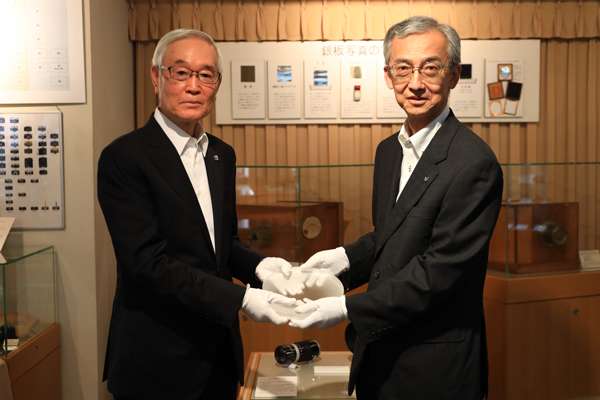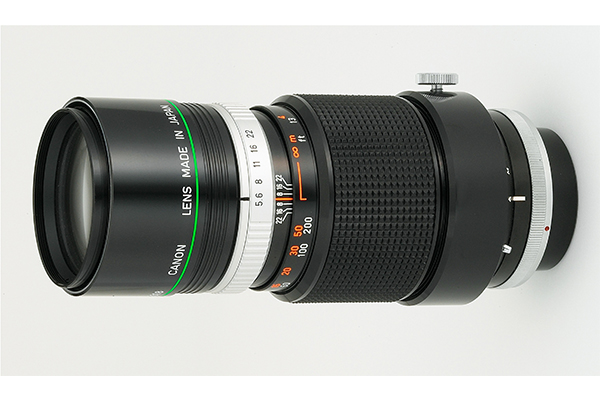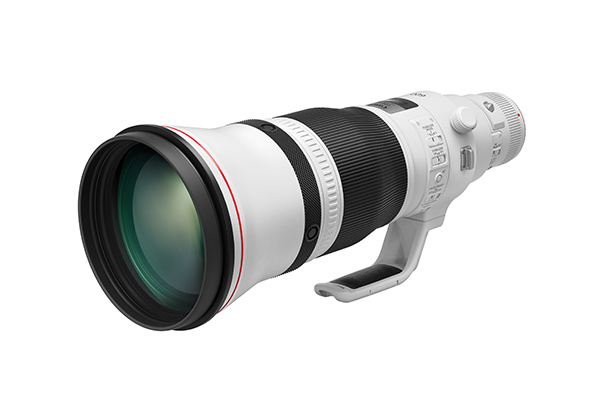News Release
Canon Optron Inc.
Canon Optron donates artificially crystallized fluorite, recognized for its 50-year legacy of contributing to optical science, to the JCII Camera Museum
TOKYO, July 2, 2020—Canon Inc. announced today that its subsidiary company, Canon Optron Inc. has donated an artificially crystallized fluorite produced at Canon Optron's headquarters in Yuki City, Ibaraki Prefecture, to the Japan Camera Industry Institute (JCII). The crystal will go on display at the JCII Camera Museum in Tokyo's Chiyoda Ward starting tomorrow.

The artificially crystallized fluorite donated by Canon

Presentation of the artificially crystallized fluorite
The JCII Camera Museum owns and displays a wealth of historically significant photos and photography-related equipment from Japan and many other countries. The museum, in recognition of synthetic fluorite's more 50-year legacy of contribution to photography, has requested that Canon Optron manufacture one of these crystals for display as part of the museum collection.
It has long been known that when combined with optical glass, fluorite, the mineral form of calcium fluoride (CaF2), can correct for chromatic aberration in a manner that is close to ideal. In the more than 50 years since Canon introduced the FL-F300mm f/5.6, the world's first consumer-grade interchangeable lens in May 1969, the company has included lens elements made using synthetic fluorite in many of its high-performance lenses. Canon Optron, in addition to producing synthetic fluorite lens elements for Canon interchangeable-lens camera and broadcast lenses, manufactures lenses for telescopes used by astronomical observatories, ultraviolet microscopes and many other types of optical equipment, helping to advance state of the optics industry.
Comment from Yasunori ICHIKAWA, JCII Camera Museum Steering committee member
"Fluorite possess incredibly unique optical qualities. Because of its high transmission of visible, ultraviolet and infrared light wavelengths, it has long been used in microscopes and various applications of scientific photography. While today, it is used in low-dispersion lens elements, Canon's history of use of fluorite in their high-performance lens designs spans more than 50 years. As an optical material that can be grown in a crystallized form and possesses superb characteristics, the existence of synthetic fluorite is, in my opinion, historically valuable. Starting tomorrow, it will become part of the permanent collection and displayed in the "Lens Corner" of the museum."
About the JCII Camera Museum
| Permanent Exhibit | "Historical Cameras of Japan", others |
| Business Hours | 10:00 - 17:00 |
| Closed | Mondays (Tuesday if Monday is a national holiday), New Year's holidays and others specified by the Museum |
| Admission | General: 300 yen / Middle school and younger: Free Group discount for parties of10 or more (General admission: 200 yen) |
| Address | 25 Ichiban-cho, Chiyoda-ku, Tokyo 102-0082 Japan |
| Website | http://www.jcii-camera.or.jp/e/museum/index.html |
Reference
To date, Canon has released 37 lens models (including 28 EF lens models) that employ fluorite lens elements, with 10 of those models still produced. (As of July 2, 2020)

FL-F300mm F5.6
Canon's first interchangeable lens using synthetic fluorite

EF600mm F4L IS III USM
Canon's latest lens using synthetic fluorite
EF lenses that employ fluorite
| Product | Release date | No. of Fluorite elements |
|---|---|---|
| FL-F300mm F5.6 | May 1969* | 2 |
| FL-F500mm F5.6 | June 1969* | 1 |
| FL300mm F2.8 S.S.C. fluorite | February 1974* | 1 |
| FD300mm F2.8 S.S.C. fluorite | October 1975* | 1 |
| FD500mm F4.5L | May 1975* | 1 |
| New FD300mm F2.8L | April 1981* | 1 |
| New FD500mm F4.5L | December 1981* | 1 |
| New FD100-300mm F5.6 L | November 1985* | 1 |
| New FD80-200mm F4L | November 1985* | 1 |
| EF100-300mm f/5.6L | June 1987* | 1 |
| EF300mm f/2.8L USM | November 1987* | 1 |
| EF50-200mm f/3.5-4.5L | June 1988* | 1 |
| EF600mm f/4L USM | November 1988* | 1 |
| EF500mm f/4.5L USM | March 1992* | 1 |
| EF1200mm f/5.6L USM | July 1993* | 2 |
| EF400mm f/2.8L II USM | March 1996* | 1 |
| EF100-400mm f/4.5-5.6L IS USM | November 1998* | 1 |
| EF300mm f/2.8L IS USM | July 1999* | 1 |
| EF500mm f/4L IS USM | July 1999* | 1 |
| EF400mm f/2.8L IS USM | September 1999* | 1 |
| EF600mm f/4L IS USM | September 1999* | 1 |
| EF70-200mm f/4L USM | Sep-99 | 1 |
| EF400mm f/4DO IS USM | December 2001* | 1 |
| EF70-200mm f/4L IS USM | November 2006* | 1 |
| EF200mm f/2L IS USM | Apr-08 | 1 |
| EF800mm f/5.6L IS USM | May-08 | 2 |
| EF70-200mm f/2.8L IS II USM | March 2010* | 1 |
| EF300mm f/2.8L IS II USM | Mar-11 | 2 |
| EF400mm f/2.8L IS II USM | August 2011* | 2 |
| EF500mm f/4L IS II USM | May-12 | 2 |
| EF600mm f/4L IS II USM | May 2012* | 2 |
| EF200-400mm f/4L IS USM EXT1.4X | May-13 | 1 |
| EF100-400mm f/4.5-5.6L IS II USM | Dec-14 | 1 |
| EF70-200mm f/4L IS II USM | Jun-18 | 1 |
| EF70-200mm f/2.8L IS III USM | Sep-18 | 1 |
| EF400mm f/2.8L IS III USM | Dec-18 | 2 |
| EF600mm f/4L IS III USM | Dec-18 | 2 |
- *Production finished
Characteristics of fluorite
When light meets water or other transparent matter, it is refracted. Lenses are used to take advantage of this property and focus light that passes through them. However, the degree to which light is refracted depends on the color. For example, blue light, which has a short wavelength will be refracted at a steeper angle than red light, which has a long wavelength. For that reason, even light from the same source will be split by color when it passes through a lens and focused on to various different points, leading to the occurrence of color blurring known as "chromatic aberration."

An image captured with a telephoto lens where chromatic aberration can be seen around the edge of the branch in the yellow circle
Because chromatic aberration occurs in the opposite direction through a convex lens and a concave lens, it is possible to offset the aberration by combining a small-dispersion convex lens with a high-dispersion concave lens to align the direction of light rays with different wavelengths (such as red and blue) together at the same focal point. However, even with lenses that correct chromatic aberration, if you look closely at the focal point, the intermediate green light between the red and blue wavelengths will still converge at a different point. This chromatic aberration, which remains even after chromatic aberration correction design measures are carried out, is called secondary chromatic aberration, or secondary spectrum. The suppression of this secondary spectrum is where fluorite comes into play.
Compared with optical glass, fluorite lenses have a considerably lower refraction index, low dispersion and extraordinary partial dispersion, and high transmission of infrared and ultraviolet light. Achromatic performance can be achieved by making a convex lens with fluorite, rather than optical glass, to decisively reduce secondary spectrum, causing red, blue and green light rays to almost completely converge on the same focal point to significantly reduce the occurrence of chromatic aberration.

Optical characteristics of optical glass and fluorite
The effects of secondary spectrum are more pronounced for telephoto lenses due to their long focal lengths. To that end, Canon employs fluorite in such contemporary lenses as the EF400mm f/2.8L IS III USM and EF600mm f/4L IS III USM (both released in December 2018). This series of telephoto lenses employing fluorite has earned strong support from photographers worldwide for their subtle rendering and high contrast.
